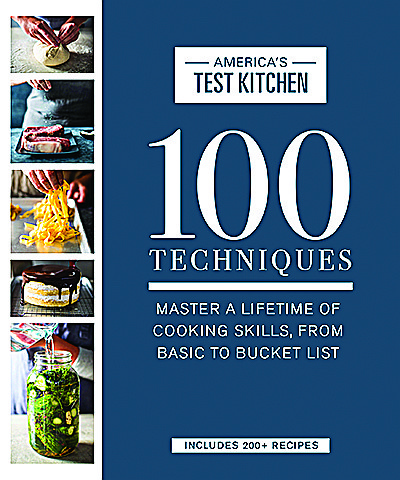If you are using your time at home to improve your cooking skills, America's Test Kitchen has a new cookbook that can help. Called "100 Techniques," it's the first technique-focused book from the Boston-based media company that produces a public television cooking show, several magazines and countless cookbooks.
Along with walking you through the techniques, which include baking bread, butterflying a chicken, braising short ribs and tempering eggs, the book also includes more than 200 recipes.
From the new book, here's the recipe for making fresh pasta without a machine.
Fresh Pasta Without
A Machine
For delicate, golden pasta ribbons with a springy bite, olive oil and egg yolks were key for structure, while the right rolling and lifting techniques helped us avoid using too much flour and making the pasta gummy. If using a high-protein all-purpose flour such as King Arthur, increase the number of egg yolks to seven. The longer the dough rests in step 2, the easier it will be to roll out. When rolling out the dough, avoid adding too much flour, which may result in excessive springback.
Serves 4 to 6 (Makes 1 pound)
2 cups (10 ounces) all-purpose flour, plus extra as needed
2 large eggs plus 6 large yolks
2 tablespoons extra-virgin olive oil
Table salt for cooking pasta
Process flour, eggs and yolks, and oil in food processor until mixture forms cohesive dough that feels soft and barely tacky to touch, 45 seconds. (If dough sticks to your fingers, add up to 1/4 cup flour, 1 tablespoon at a time, until barely tacky. If dough doesn't become cohesive, add up to 1 tablespoon water, 1 teaspoon at a time, until it just comes together; process 30 seconds longer.)
Turn out dough onto dry counter and knead until smooth, 1 to 2 minutes. Shape dough into 6-inch-long cylinder. Wrap in plastic wrap and let rest at room temperature for at least 1 hour or up to 4 hours.
Cut cylinder crosswise into 6 equal pieces. Working with 1 piece of dough at a time (rewrap remaining dough), dust both sides with flour, place cut side down on clean counter, and press into 3-inch square. Using heavy rolling pin, roll into 6-inch square. Dust both sides of dough lightly with flour.
Starting at center of square, roll dough away from you in one motion. Return rolling pin to center of dough and roll toward you in single motion. Repeat rolling steps until dough sticks to counter and measures roughly 12 inches long. Lightly dust both sides of dough with flour and continue to roll until dough measures roughly 20 inches long and 6 inches wide, frequently lifting dough to release it from counter. (You should be able to easily see outline of your fingers through dough.) If dough firmly sticks to counter and wrinkles, dust dough lightly with flour.
Transfer pasta sheet to clean dish towel and let stand, uncovered, until firm around edges, about 15 minutes; meanwhile, roll out remaining dough.
Starting with 1 short end, gently fold 1 pasta sheet at 2-inch intervals until sheet has been folded into a flat, rectangular roll. Using a sharp chef's knife, slice crosswise into 3/16-inch-thick noodles. Use your fingers to unfurl noodles and transfer to baking sheet. Repeat folding and cutting with remaining sheets of dough. Cook noodles within 1 hour or freeze for up to 2 weeks.
Bring 4 quarts water to boil in large pot. Add pasta and 1 tablespoon salt and cook until tender but still al dente, about 3 minutes. Drain pasta, reserving cooking water as needed for sauce.
Excerpted with permission from "100 Techniques: Master a Lifetime of Cooking Skills, from Basic to Bucket List," by America's Test Kitchen.

